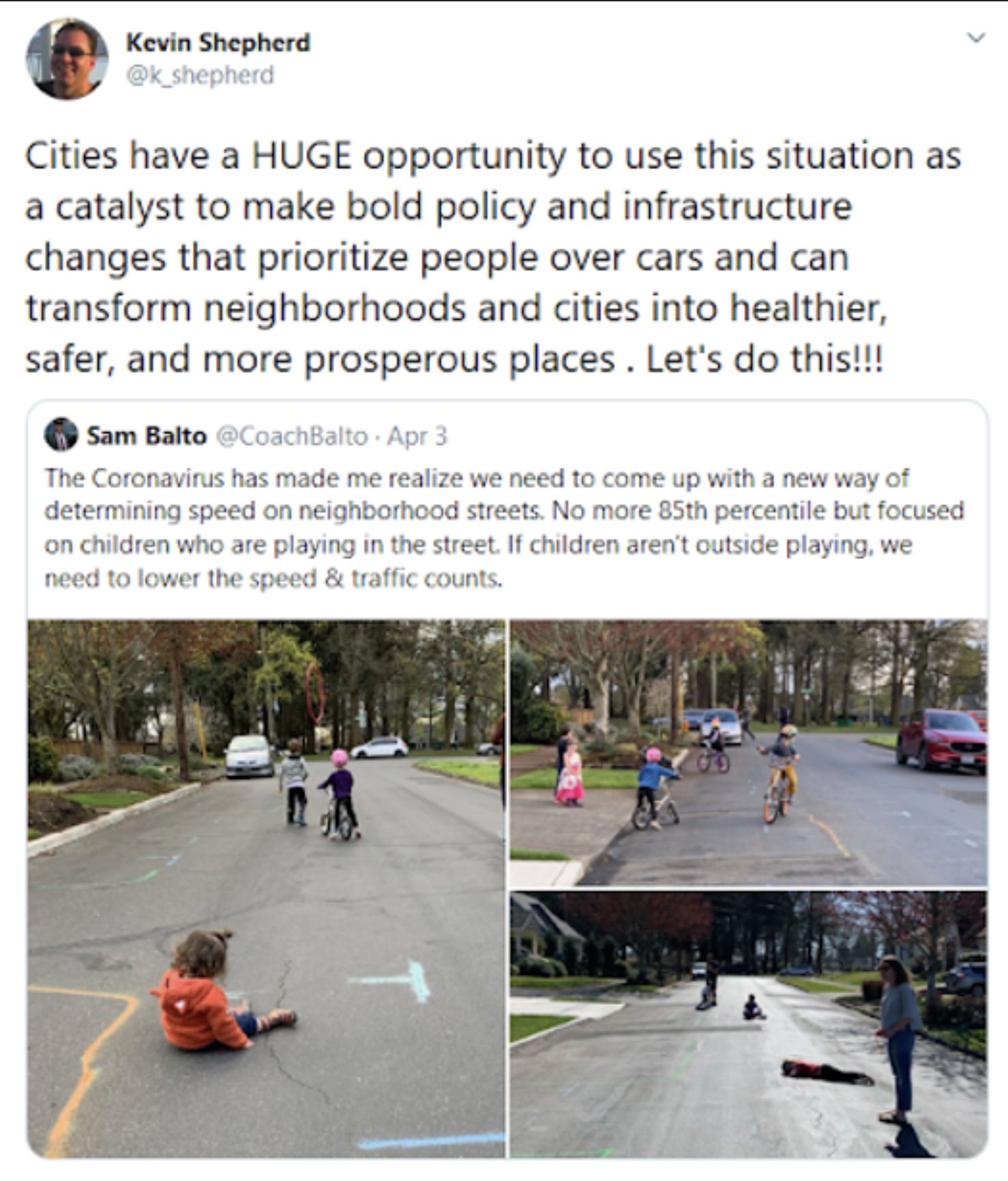What should we do?
Hey everyone!
We hope you are all doing well during this strange time. Though much of our activity has obviously been put on hold, our board has continued to meet via Zoom to catch up with one another, and also to strategize about what (if anything) we as an organization should be doing in light of the pandemic.
We wanted to bring you all in on the conversation. So below is a summary of some of our thoughts. But first, an important statement. This is a scary and even devastating time for many, and we do not take that lightly. The following thoughts are just thoughts, and we are in no way claiming that they should be the center of anyone’s attention right now.
That being said…
The Streets!
You can’t not notice. The streets are open, and the air is clean. People are at home - all day and all week in the neighborhoods they live in. Families are taking strolls together in the evening. Neighbors spread out their beach chairs and drink and chat. Public space strangely and welcomingly seems to be populated more with people than with cars. While parts of us wonder when life can go back to normal, parts of us wonder whether it has to.
A common intuition many of us seem to share (but may be unable or hesitant to articulate) is: is this a massive, unexpected chance for widespread reconceptualization of public space?
If you’ve thought, in the back of your mind, that it would be a shame for the streets to fill up with cars again immediately following this mess, you’re not alone. Many are thinking it:
These are sound thoughts. Our streets, one may say, are normally ugly, unpleasant, dangerous, dirty, and too crammed with cars. While many agree with this sentiment, a lot of people understandably just can’t imagine how that could ever be changed. But now maybe we can imagine it. Will people start driving cars to the extent they did before, after having become black belts at telecommuting? After having experienced the simple pleasures of being at home more, living frugally, cooking real food, and getting to know their neighbors and neighborhood?
If the quarantine order had lasted only a day or two, every aspect of our lives would have immediately bounced back to normal. But this will go on for months. And, the longer the quarantine lasts, the longer the changes will last.
Traffic counts - the data that engineers and bureaucrats use to justify the amount of public space “needed” to move all the cars through - are normally consistent. But 2020 is throwing a wrench in that whole system. What is the baseline anymore? How can we use the old numbers to justify the current overcapacity of our streets? Not only are the daily counts much lower than what the streets are designed for, but also - the world may be very different on the other side of this. Maybe the current counts should be the new norm. The new baseline. And maybe we should be reducing “vehicle capacity” while we have the chance.
The standard justification for not providing space within the public right of way for other modes of mobility (or shade trees, or anything else besides space for cars for that matter) is that “there’s just no room.” The argument is that taking space away from cars would cause traffic jams, because the number of cars going through each street each day is constant. But the cars are gone. The patterns have broken. There is room. And there will be for a few more months.
The Circulation Element of our 2015-2035 General Plan makes it very clear that we, as a city, have already decided what kind of future we want. Consider the following goals:
Goal C‐1: Implement “Complete Streets” Policies on Roadways in Costa Mesa
Plan, develop, and implement a comprehensive transportation system that serves all users and modes of travel...
Goal C-7: Promote a Friendly Active Transportation System in Costa Mesa
Create a bicycle and pedestrian friendly environment throughout Costa Mesa for all types of users and all trip purposes...
Goal C-8: Create a Safer Place to Walk and Ride a Bicycle
Provide a safe, convenient, and attractive bicycling and pedestrian environment...
Are we serious about implementing the goals of our General Plan?
Right now may not be the appropriate time for action. Our leaders and public servants are scrambling to prepare for what’s predicted as the region’s peak of the pandemic. We need to brace ourselves and let them focus and do their work. But eventually we’ll get over the hump. But by then we should be ready to act. Which means that the time to think and plan is now.
Again, these are just thoughts. We want you to be part of the conversation.
How have you been experiencing the streets differently?
How might this time of quarantine affect neighborhoods and cities?
Do you think commuting/driving patterns will go back to normal? And would a change in commuting/driving patterns be good? Why or why not?
How ought we (sensitively) take advantage of this opportunity to improve our city?
Email us, or share your thoughts with us via social media. Be in touch with us, and we will try to stay in touch with you. Here are the links to some of the articles referenced in the Tweets above:
Build Cities for Bikes, Buses, and Feet—Not Cars (Wired) There’s no better time for cities to take space away from cars (The Verge) COVID19 Legacy: The Death of the Avoidable Car Trip? (Streetsblog)
The CMABS Team








